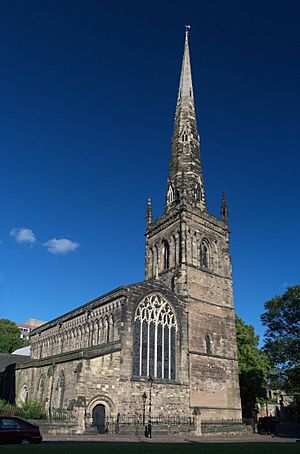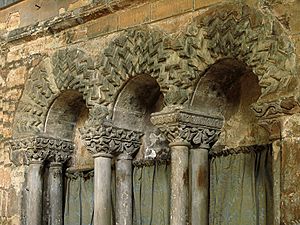Church of St Mary de Castro, Leicester facts for kids
Quick facts for kids St Mary de Castro, Leicester |
|
|---|---|

The church of St Mary de Castro,
before the removal of its unsafe spire |
|
| 52°37′56″N 1°08′25″W / 52.6323°N 1.1404°W | |
| Denomination | Church of England |
| Churchmanship | Anglo-Catholic |
| History | |
| Dedication | St Mary de Castro "St Mary of the Castle" |
| Administration | |
| Parish | Leicester |
| Diocese | Leicester |
| Province | Canterbury |
St Mary de Castro is a very old church in Leicester, England. It's a "Grade I listed building," which means it's super important historically. You can find it inside the old Leicester Castle grounds.
The church's name, "St Mary de Castro," is Latin for "St Mary of the Castle." This name helped people tell it apart from another church nearby called "St Mary de Pratis," which meant "St Mary of the Meadows."
The church was closed for a while in 2011 because its tall, pointy roof (called a spire) was unsafe. It reopened in 2015 after the spire was taken down. There isn't enough money yet to rebuild the spire and fix the tower underneath it.
St Mary de Castro was probably the first church in the UK that you could explore online using Google Street View. It was photographed for this in August 2012.
Contents
A Look at the Church's History
The church was first built around 1107. This was after King Henry I of England gave the land and castle to Robert de Beaumont, 1st Earl of Leicester. Some historians think an older church might have been there before, and Robert just fixed it up.
Robert de Beaumont made it a special kind of church called a collegiate church. This meant it had a Dean and 12 Canons (priests) who worked there. It was dedicated to the Virgin Mary and All Souls. It also served as a chantry chapel, a place where prayers were said for the souls of Robert, his family, and the first three Norman kings.
In 1143, Robert's son, Robert le Bossu, moved some of the church's money and land to his new church, Leicester Abbey. But St Mary de Castro still had a dean, six clerks, and a chaplain. It also kept money from offerings and most of its tithes (a type of tax). This special collegiate setup lasted until 1548.
The church built in the early 1100s didn't have side sections (called aisles). Some parts of those original walls are still there today. The church got much bigger in the 1160s. A north aisle was added, along with new doorways on the north and west sides. The main part of the church (the chancel) was also made longer.
The two new doorways have cool zigzag patterns, which are typical of Norman design. Inside the chancel, you can see stone seats called Sedilia and a basin called a Piscina. These are considered "the finest piece of Norman decoration" in the whole county!
In the 1200s, more changes were made, especially to the transepts (the arms of the cross-shaped church) and the south aisle. The south aisle was made much wider than the main part of the church (the nave). This gave more space for local people to worship. Around 1300, a huge east window was added to the south aisle, with amazing stone patterns called tracery.
The church's tower was built inside the south aisle. It has a decorative border called a quatrefoil frieze and four fancy pinnacles (small spires). From the top of the tower, a tall, thin spire rose up. This spire was rebuilt in 1783, but it kept its decorative hooks (called crockets) and three levels of small windows (called lucarnes). In the 1860s, the inside of the church was worked on by a famous architect named George Gilbert Scott.
The Spire's Story
The church had to close because its spire became unsafe. This tall, eight-sided spire was from the 14th century, but it had been rebuilt in 1783. In September 2013, long cracks, up to six meters (about 20 feet) long, appeared on four sides of the spire.
Experts checked it and said it was in danger of falling down. Because it was so bad, the spire had to be taken down in 2014. This cost a lot of money, around £200,000. People have raised over £358,000 since 2011, but more money is still needed to rebuild the spire and fix the tower below it.
Famous People and Events
This church has seen some interesting moments in history!
It's believed that around 1366, the famous writer Geoffrey Chaucer might have gotten married here. He supposedly married Philippa (de) Roet, who was a lady-in-waiting to Queen Philippa of Hainault. Philippa's sister, Katherine Swynford, later married Chaucer's friend and supporter, John of Gaunt.
In 1426, the young King Henry VI of England was made a knight in this church. His uncle, John of Lancaster, Duke of Bedford, who was ruling France at the time, knighted him. After that, King Henry himself knighted 44 more people on the same day! The first person he knighted was Richard Plantagenet, 3rd Duke of York.
William Bickerstaffe, a kind local schoolmaster and someone who studied old things (an antiquarian), was connected to this church. He was baptized here, buried here, and worked as a curacy (a type of assistant priest) for seven years.
The Church Organ
The church has a large pipe organ with three keyboards (manuals). It was first put in the church in 1860 by a company called Forster and Andrews. The organ has been worked on and fixed up several times since then, in 1880 and again in 1960. You can find more details about this organ on the National Pipe Organ Register.
See also
 In Spanish: Iglesia de Santa María de Castro para niños
In Spanish: Iglesia de Santa María de Castro para niños
- Anglican churches in Leicester
- Grade I listed buildings in Leicester


